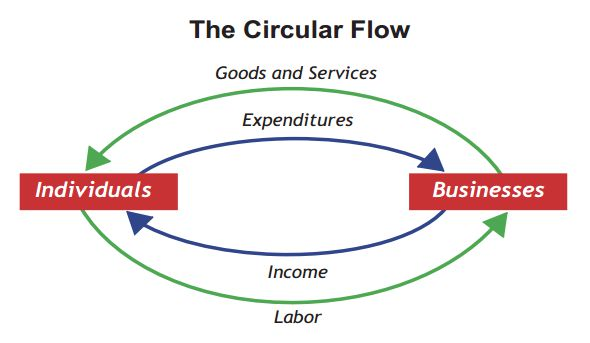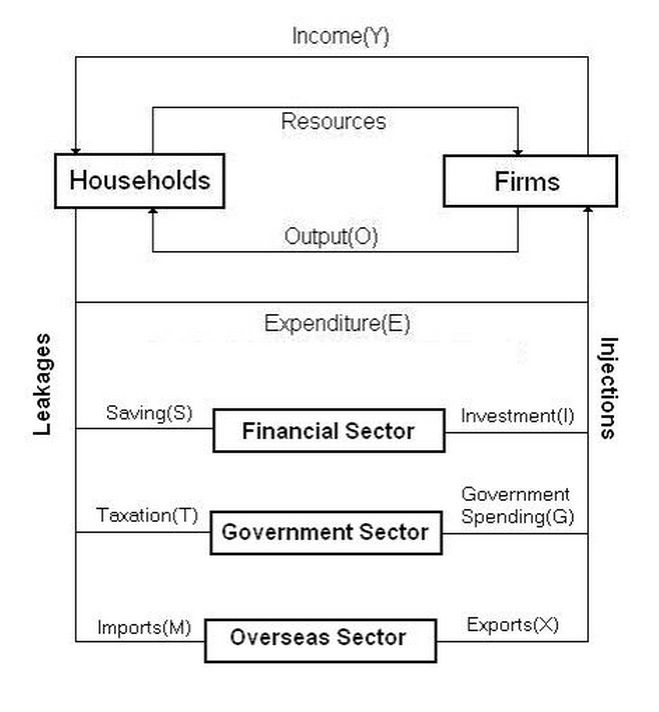AQA Specification focus:
‘The effect of changes in injections and withdrawals on national income.’
Introduction
Injections and withdrawals play a crucial role in determining the level of national income. Shifts in their balance directly influence economic performance, growth, and equilibrium stability.
Understanding Injections and Withdrawals
Injections
Injections are additions of spending into the circular flow of income from outside the domestic household–firm relationship. These increase aggregate demand and stimulate production.
Government spending on goods, services, and welfare programmes
Investment by firms in capital goods
Exports, since foreign demand for domestic products brings in new income
Injections: Exogenous additions to the circular flow of income, including investment, government expenditure, and exports.
Withdrawals
Withdrawals (also called leakages) represent income that leaves the circular flow, reducing demand for domestically produced goods and services.
Saving by households in financial institutions
Taxes collected by the government
Imports, which redirect domestic spending towards foreign goods
Withdrawals: Exogenous reductions from the circular flow of income, including savings, taxes, and imports.
Equilibrium and Disequilibrium
The Role of Balance
Equilibrium national income occurs when total injections equal total withdrawals. At this point, planned spending matches output, and the economy operates at a sustainable level.

This diagram depicts the fundamental circular flow of income, showing the continuous movement of money between households and firms. It serves as a basis for understanding how injections and withdrawals affect national income. Source
Equilibrium Condition: Injections (J) = Withdrawals (W)
J = I + G + X
I = Investment
G = Government spending
X = Exports
W = S + T + M
S = Savings
T = Taxes
M = Imports
If injections exceed withdrawals, the economy expands. If withdrawals exceed injections, output contracts.

The five-sector circular flow model illustrates the complex interactions between different economic agents. It shows how changes in injections and withdrawals can lead to economic expansion or contraction. Source
Disequilibrium Effects
Excess injections: National income rises as firms increase output to meet rising demand.
Excess withdrawals: National income falls as spending weakens and production declines.
Impact of Changes in Injections
Increase in Injections
When injections grow (e.g., increased government investment in infrastructure):
Firms face greater demand, leading to higher output.
Employment rises as production expands.
Household incomes grow, feeding back into further consumption.
Decrease in Injections
If injections fall (e.g., reduced business investment):
Aggregate demand weakens.
Firms cut back production, lowering employment.
National income contracts, possibly triggering recessionary pressures.
Impact of Changes in Withdrawals
Increase in Withdrawals
Greater withdrawals (e.g., higher taxes or rising imports):
Domestic demand falls as households and firms reduce spending.
Lower demand causes contraction in output.
National income decreases, potentially increasing unemployment.
Decrease in Withdrawals
Reduced withdrawals (e.g., tax cuts or lower household savings):
Consumption increases, boosting aggregate demand.
Firms respond by raising output and employing more resources.
National income expands, supporting economic growth.
Interaction Between Injections and Withdrawals
Multiplier Effects
A small rise in injections or reduction in withdrawals can generate a larger increase in national income through the multiplier process, as higher incomes fuel more spending.
Dynamic Adjustments
Short-term: Output adjusts faster than prices, so changes affect real national income significantly.
Long-term: Persistent imbalances may alter inflation, trade positions, and government policy responses.
Application in Economic Context
Policy Implications
Governments and central banks monitor injections and withdrawals closely because they guide policy:
Expansionary fiscal policy (raising government spending or cutting taxes) increases injections and reduces withdrawals.
Contractionary fiscal policy (raising taxes or cutting spending) increases withdrawals and reduces injections.
Global Influences
External shocks — such as a surge in export demand or global financial crises — shift injections and withdrawals, influencing national income beyond domestic policy control.
Key Points Recap in List Form
Injections: Investment, government spending, exports.
Withdrawals: Saving, taxes, imports.
Equilibrium: Achieved when injections = withdrawals.
National income rises when injections > withdrawals.
National income falls when withdrawals > injections.
Multiplier effect magnifies changes.
Policy and global factors strongly influence outcomes.
FAQ
Short-term fluctuations often arise when injections or withdrawals change unexpectedly. For instance, a sudden rise in investment can temporarily boost national income, while higher savings or taxation can reduce spending power.
These imbalances can lead to growth spurts or slowdowns before the economy readjusts to a new equilibrium where injections equal withdrawals again.
Imports are treated as withdrawals because money spent on foreign goods leaves the domestic economy. This reduces demand for domestically produced goods and services.
As a result, while households may enjoy more choice, the direct impact is a reduction in domestic output and employment unless matched by equivalent export earnings.
Governments use fiscal policy tools to influence injections and withdrawals:
Increasing government spending (injection) during downturns.
Cutting taxes to reduce withdrawals and boost consumption.
Raising taxes or cutting spending in booms to reduce inflationary pressures.
Such policies aim to stabilise national income by keeping injections and withdrawals in balance.
Yes. For example, poorly targeted government spending may increase demand but create inefficiencies, waste, or inflation.
Similarly, excessive foreign investment could lead to future profit outflows, reducing long-term income retention within the domestic economy.
While savings reduce immediate spending, they provide funds for banks to lend to businesses. This can stimulate future investment, turning today’s withdrawal into tomorrow’s injection.
In economies with well-functioning financial markets, this process supports sustainable long-term growth by financing productive capital expenditure.
Practice Questions
Define the term injections in the context of the circular flow of income. (2 marks)
1 mark for identifying that injections are additions to spending in the circular flow of income.
1 mark for stating examples such as investment, government spending, or exports.
Explain how an increase in withdrawals can affect the level of national income. (6 marks)
Up to 2 marks for identifying what withdrawals are (savings, taxes, imports) and that they represent leakages from the circular flow.
Up to 2 marks for explaining that an increase in withdrawals reduces aggregate demand, leading to lower output.
Up to 2 marks for linking this to the effect on national income, such as reduced employment and possible contraction in economic growth.

